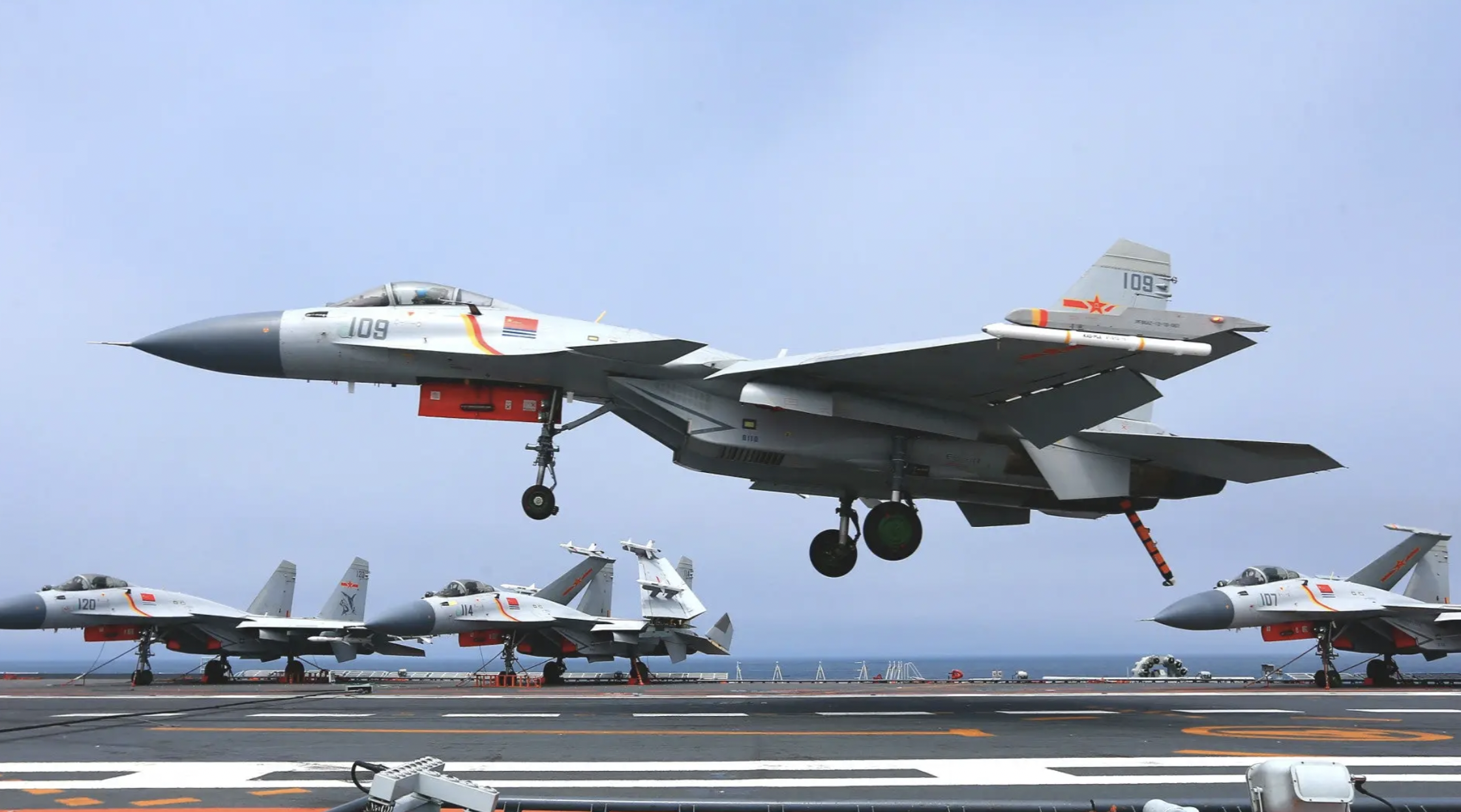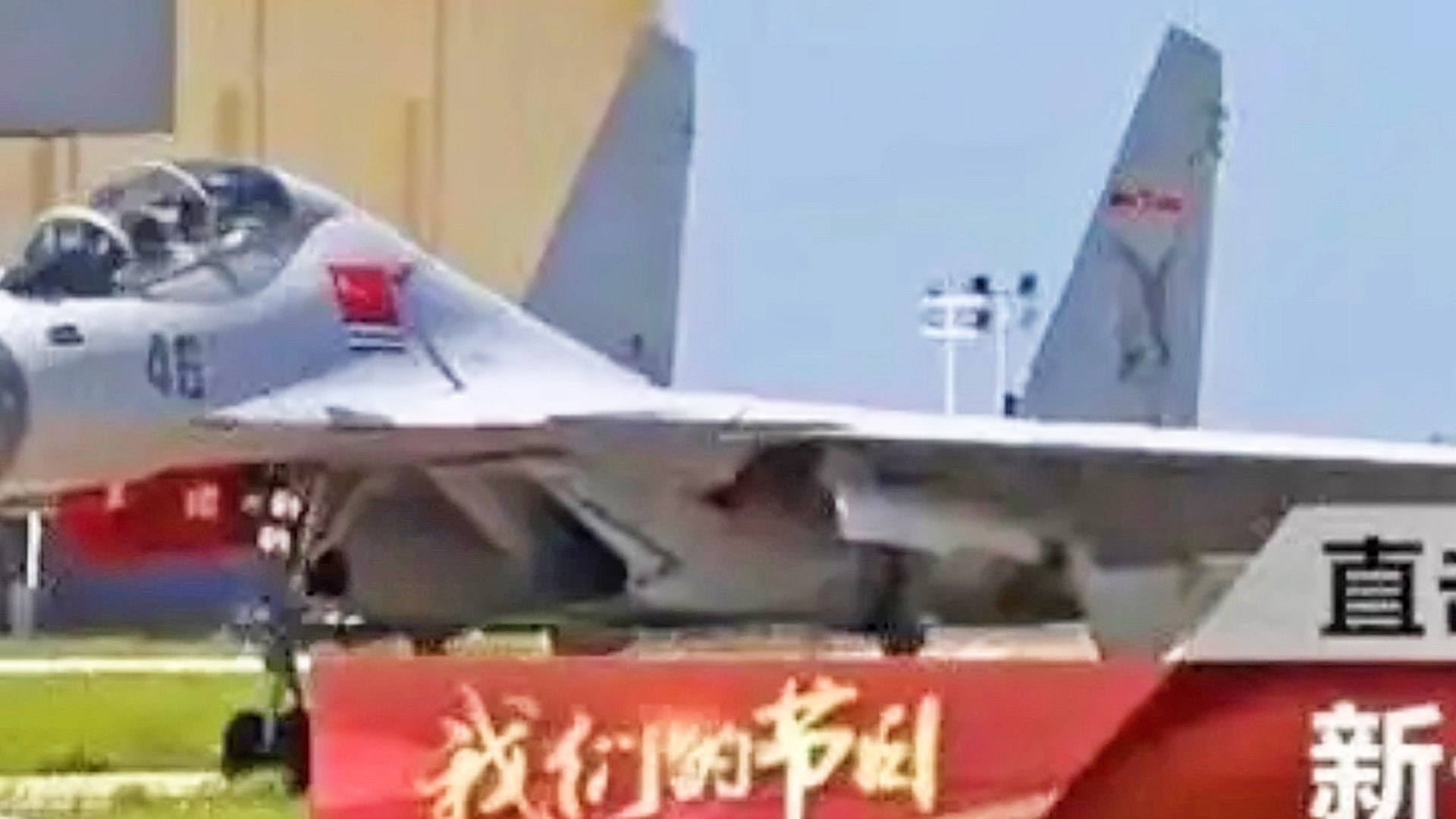An image that recently appeared on social media shows a series-production example of China’s enigmatic J-15S in the most detail we’ve seen so far. The ultimate objective behind the two-seat J-15S remains barely known, with conflicting reports that it is intended as a carrier trainer, a multirole strike fighter, or simply as a testbed. Meanwhile, the basic platform has already served as a springboard for a carrier-based electronic warfare (EW) jet, the J-15D.
Apparently taken from a TV news report, the latest image of an operational J-15S shows the two-seater in its PLAN colors, parked alongside a single-seat J-15 carrier fighter, which is by now well established in Chinese service.
The operational J-15S carries the code 46 on its forward fuselage and has standard PLAN markings, including the ‘Flying Shark’ logo on the tailfins, but is seen completely unarmed, without even weapons pylons fitted.
While it’s now apparently clear that the J-15S has entered PLAN service, we still don’t know exactly which role it will fulfill. First off, though, it’s important to note that, unlike the single-seat J-15, which is essentially a Chinese clone of the Su-33 Flanker-D as flown by the Russian Navy, the J-15S has no Russian or Soviet equivalent.
While Russia did develop a prototype two-seat carrier Flanker, the Su-33UB had side-by-side seating, very much like the Su-34 Fullback strike aircraft, but it never made it into service.
Instead, the J-15S has a more conventional tandem two-seat configuration. Most likely, it seems the navalized J-15 airframe was combined with the forward fuselage of the land-based J-11BS combat-capable trainer.
Interestingly, however, the J-15 airframe used is the original model that’s equipped for short take-off but arrested recovery, or STOBAR, operations. This means the J-15S is compatible with the PLAN’s first two aircraft carriers, Liaoning, and Shandong, which aren’t fitted with catapults and instead use a ‘ski jump’ takeoff ramp. The PLAN’s latest carrier, the recently launched Fujian, does have catapults and a catapult-assisted take-off but arrested recovery, or CATOBAR, version of the single-seat J-15 has been developed to operate from it and subsequent vessels.

Standard single-seat J-15s train aboard the carrier Liaoning:

As it stands, the J-15S is therefore not equipped for catapult launch but it does incorporate some other interesting features. The cockpit canopy has been changed, with an enlarged transparency that provides a better view forward for the back-seater, as is typical on two-seat Flanker variants. While this ‘stadium’-like seating would be ideal for a trainer, it is also beneficial in air combat scenarios, too.
The first J-15S prototype reportedly flew in late 2012 and seems to have been followed by a second sometime in 2014, although this timeline is unconfirmed. Regardless, these two aircraft are powered by Chinese-made WS-10 engines rather than the Russian AL-31F turbofans used on earlier Chinese Flanker versions, including the single-seat J-15s.
Ever since the two-seat carrier-capable Flanker appeared, there was speculation about its planned role. Some suggested it would be used simply as a carrier trainer. This would make some sense as it has become widely known that China has had more than its fair share of mishaps as it works to perfect carrier aviation. Although, the choice of WS-10 engines makes this seem less likely, since these have otherwise been typically reserved for ‘higher-end’ Flanker variants.
Otherwise, a two-seat J-15 would be ideal for more demanding multi-role missions flown from carrier decks, including long-range strike, close air support, and complex air defense missions. In this way, the J-15S could become a carrier-based equivalent to the two-seat J-16 used by the People’s Liberation Army Air Force, or PLAAF. It would broadly fulfill the same role as the F/A-18F Super Hornet in the U.S. Navy’s carrier air wing. There is also the future of manned-unmanned teaming on the horizon, which China is actively working to develop like its U.S. counterpart. A two-seat fighter that can work as a command and control platform for combat drones would be ideal.
Whatever the truth, it seems the two J-15S prototypes have also been used as testbeds for the J-15D, a carrier-based electronic warfare jet, broadly equivalent to the U.S. Navy’s EA-18G Growler, but likely also with a multirole strike mission.
Reports suggest that the prototype J-15D took to the air in late 2016. Like the land-based J-16D, this variant is characterized by large wingtip EW pods and it has the infrared search and track (IRST) sensor and gun removed. Additional conformal and blade antennas are located around the airframe and further EW pods can be carried under the wings and below the fuselage.
The appearance of an in-service J-15S suggests that either this aircraft is indeed intended as a trainer, or it’s expected to serve in a frontline role that’s additional to, or complementary to the J-15D.
Moreover, there remains the question of what purpose the STOBAR J-15S and J-15D serve, when work on a CATOBAR-capable J-15T is already well underway. Using STOBAR versions of the J-15 implies reduced weapons and fuel loads so that the jets are light enough to get off the deck safely and it’s questionable if their development would be worthwhile if they will only ever operate from the first two PLAN carriers.

Perhaps the most logical solution would be a CATOBAR-capable two-seater that combines the multirole strike and EW functions of the J-15S and J-15D — such an aircraft is rumored to be designated J-17. This would be able to operate from the Fujian and subsequent carriers, with all the benefits this would offer in terms of increased payloads of fuel and weapons.
The War Zone spoke to Chinese military aviation expert Andreas Rupprecht, who is of the opinion that the J-15S is likely being used by the PLAN as a trainer, “since it is currently assigned to the Naval Aviation University.”
However, Rupprecht adds that he expects the J-15S is not a simple trainer for the single-seat J-15, since it is arriving in service too late for this particular role. Instead, he expects it will be used to train crews for future twin-seater carrier Flanker variants, namely the J-15D and the rumored J-17, both of which require a second pilot as a mission specialist.
In terms of overall J-15 production, Rupprecht notes that the code number 46 is of interest. “We have J-15s numbered 01 to 24, then 30 to 35, and then there is a huge gap since the second unit/regiment has numbers ranging from 60 to 90.” This suggests that the interval between 35 and 60 might eventually be filled with J-15S aircraft.
If Rupprecht’s carrier trainer theory is correct, then it might be that the PLAN uses the J-15S aboard the Liaoning and Shandong, which are already used to a significant degree for trials and evaluation work, as the PLAN builds up its carrier aviation experience. In this way, it could use these aircraft to build up an experienced cadre of aircrews who can then operate more advanced J-15/J-17s — and perhaps even more advanced J-35 fighter jets — from the Fujian, and subsequent CATOBAR-equipped flattops. That, however, is only speculation at this stage.
As with many aspects of the Chinese Flanker dynasty, and especially the advanced carrier-based derivatives, the truth behind the J-15S remains elusive, at least for now.
Contact the author: thomas@thedrive.com
